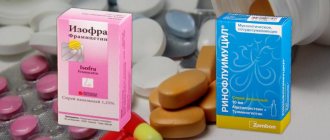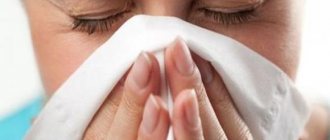Causes and possible complications
Green snot may be a sign of sinusitis
Nasal discharge occurs as a result of an inflammatory process in the nasal mucosa. If the snot is green, this usually indicates that rhinitis is also caused by a bacterial or viral infection.
Green snot often appears in the last stages of a runny nose. In this case, blood cells and microorganisms that counteract inflammation are removed from the secretions. A small amount of snot and light blowing of your nose indicate the healing process.
However, it happens that such discharge can be a symptom of many diseases. Such pathologies include:
- Sinusitis (ethmoiditis, sinusitis or sinusitis). The disease is accompanied by hyperthermia, foul-smelling discharge, headache, and general weakness.
- Chronic pharyngitis and tonsillitis. Green snot in such diseases appears in the acute stage.
- Rhinopharyngitis. Discharge occurs when the pathology is advanced.
- Adenoiditis. When the adenoids become inflamed, green snot may also appear.
- Diseases of the bronchi and lungs. Often the disease is accompanied by green nasal discharge.
- Rarely, green discharge occurs as a result of meningococcal infection.
Most often, green discharge occurs if a patient with a cold is not treated properly.
You can learn more about how and how to treat a runny nose at home from the video:
Diseases that cause green snot may be accompanied by the following symptoms:
- Snoring in your sleep
- Nasal congestion
- Cough without sputum production
- Paroxysmal cough at night
- Ear pain
- Difficulty in nasal breathing
- Headache
- Dizziness
If these symptoms occur, you should contact a specialist who will prescribe appropriate treatment.
Green nasal discharge is not pus, so it is not life-threatening, but its appearance can provoke the development of many dangerous consequences.
If treatment is ignored, a bacterial infection can spread to the lower respiratory organs. Therefore, complications such as bronchitis, bronchotracheitis, pneumonia or tracheitis may develop.
In rare cases, mucus can get into the ear canals, affecting the development of otitis media. A dangerous consequence of green discharge is cerebral edema. However, this condition develops in extremely rare cases. To prevent such complications, you need to start treatment on time.
Treatment of green snot and possible complications
Today, treatment of green snot does not cause any particular problems. There are many different techniques and drugs that can get rid of this unpleasant condition. The choice of treatment method depends on the reason that provoked the thickening and change in color of the mucus.
Patient regimen and general recommendations
How to cure green snot? If the situation is not too advanced, then before using medications, you can try alternative methods aimed not only at treatment, but also at improving the health of the body as a whole. Doctors usually recommend:
- Be in the fresh air as often as possible. For walks, it is advisable to choose places that are located away from highways and chemical plants.
- Arrange regular rinsing of the nasal passages with saline solution. Such hygienic procedures help thin the mucus and remove it as quickly as possible.
- Monitor the level of air humidity in the room. If the room is too dry, the nasal mucosa may dry out, which in turn will lead to the formation of crusts, and if an infection enters the body, to the formation of a runny nose in adults.
- Carry out hardening procedures. In this case, the main thing is not to overdo it. An unaccustomed body may not be able to withstand the use of cold douches.
All of the above measures can help at the first signs of the disease. But if the green snot has become thick and is accompanied by unpleasant sensations in the sinuses, then drug therapy will be required.
Drug treatment for green runny nose
If a runny nose does not go away for a long time during a cold, then this condition can lead to the spread of the inflammatory process throughout the nasopharynx and other organs. In this case, the treatment of snot from the nose should be comprehensive.
Washing, irrigation
To liquefy accumulated mucus, rinsing is first prescribed. They are carried out with special pharmaceutical products or sodium chloride solution. At home, the easiest way is to use a syringe or syringe. Pharmaceutical preparations that contain sea water, as well as solutions with an antiseptic effect, are quite effective:
- "Aqualor";
- "Aquamaris";
- "Dolphin"
- "Furacilin".
Vasoconstrictor drops
How to treat green snot if irrigation and rinsing do not help? After performing hygiene procedures, you should put special drops into your nose. Vasoconstrictor drugs help to quickly relieve the feeling of congestion and swelling of the mucous membrane:
- "Nazivin";
- "Naphthyzin";
- "Galazolin."
You should know that they cannot be used for a long time, since the drugs can be addictive. On average, the course of treatment is no more than 5 days. Apply 1-2 drops into each nostril.
Antibacterial drugs
How to treat thick smelly snot? Unpleasant-smelling discharge indicates the development of bacterial inflammation, so antibiotics cannot be avoided in such a case. At the discretion of the doctor, penicillin, cephalosporin or macrolide drugs may be prescribed. The tablets are taken according to the instructions.
No less effective is the use of sprays and nasal drops with an antibacterial effect. These include: Isofra or Polydex. Medicines quickly thin out secretions, relieve congestion and help destroy bacteria.
Inhalations
How to get rid of green snot using inhalation procedures? For this you will need a nebulizer. A solution of sodium chloride is poured into the bowl of the device and inhaled for 5-10 minutes. Inhalations for green snot relieve congestion and act as a thinning agent. It is possible to carry out procedures with mineral water.
Also, as prescribed by a doctor, you can pour solutions of antibacterial drugs into the nebulizer. The inhaler helps deliver the medicine directly to the site of infection. The antibiotic for green snot acts locally, which enhances the effect of treatment.
Treatment of green discharge with folk remedies
How to treat green snot in an adult or child at home? Therapy with folk remedies should not be the main one. It is best if “grandmother’s” recipes are used as an addition to complex drug treatment.
Thermal treatments
What to do at home if snot flows from your nose? If body temperature is not elevated , thermal procedures can be performed. Warm foot baths or steam inhalations help a lot.
The most common remedy for treating a runny nose with green snot in adults and children is regular potatoes, boiled in their jackets. After inhaling the vapors, the consistency of the discharge becomes less thick. Liquid snot is quickly removed from the nose and sinuses, easing the patient's condition.
You can also breathe over decoctions of medicinal herbs. Inhalations with chamomile, calendula, and St. John's wort are effective in such cases.
Homemade drops
If your runny nose is green, you can try making drops at home. Here are some simple recipes:
Recipe No. 1 - Aloe
To treat greenish snot, take two aloe leaves, grind them using a grater or other device and squeeze out the juice. Boiled water is added to it in a 1:1 ratio. Homemade drops for treatment are ready. The resulting product is instilled into the nose 2-3 times a day.
Recipe No. 2 - Onions and honey
If the cause of green snot is a cold, the following home remedy will do: finely grate onions (2 tablespoons) and add 50 ml of water. Add half a teaspoon of liquid honey to the resulting solution. Folk medicine is also used instead of nasal drops.
Homeopathic medicines
How else can you treat green snot in adults? Homeopathy is quite effective in such cases. If the runny nose is severe, and the discharge is profuse and lasts more than three days, you can use a remedy such as Natrium Muriaticum. It is used diluted according to the instructions. After 3-4 days of use, the patient feels significant relief.
"Pulsatilla" is another homeopathic remedy. It can be used to treat thick yellow-green nasal discharge, especially if snot is coming from one nostril. "Pulsatilla" helps to cope with the disease quite quickly. Within 3-4 days, the severity of the pain syndrome decreases, congestion decreases, and the sense of smell is restored.
Drug treatment
Drug therapy depends on the cause that caused green snot
First of all, treatment should be aimed at eliminating the underlying cause. The following groups of medications are usually prescribed:
- Vasoconstrictors (Sanorin, Vibrocil, Naphthyzin, Otrivin, Nazol, Tizin, Rinazolin, Galazolin). These drugs help restore nasal breathing. However, the peculiarity of using these funds is that they are not allowed to be used for more than five days. Experts recommend using nasal sprays or drops that contain xylometazoline, for example, Xylene. Such drugs have advantages such as long-lasting action and minimal drying of the nasal mucosa.
- Antihistamines. Prescribed to relieve swelling of the nasal mucosa. These include Eden, Loratadine, Diazolin, Suprastin.
- Decongestants. They effectively thin out mucus that has stagnated in the nose. Rinofluimucil is effective in this regard.
- Medicines that have an astringent effect. Such products ensure the discharge of thick snot. Collargol or Protargol based on silver ions are considered effective drugs in this group.
- Antiviral drugs. Used for viral infections. Tamiflu, Remantadine or Arbidol are usually used.
- Plant-based products are used, for example, Kameton or Pinosol.
A specialist can prescribe drainage, which is popularly called “cuckoo”. In severe cases, a sinus puncture is possible.
To strengthen the immune system, you need to drink vitamin and mineral complexes, as well as immunomodulators. The choice of medications should be determined by a specialist, taking into account the diagnosis, the nature of the disease and the individual characteristics of the body.
Do you need an antibiotic?
Since green and thick nasal discharge is an inflammation accompanied by a bacterial infection, antibiotics are usually prescribed in this case. However, it is important to know that mild illness can be treated effectively without the use of such drugs.
The use of antibacterial therapy is justified if the patient has severe intoxication of the body and a high temperature that continues for a long time.
Nasal drops or sprays with a local antibiotic, for example Bioparox, Isofra, Polydexa, may be prescribed.
It is important to know that when using an antibiotic, it is necessary to consume probiotics to prevent dysbiosis.
If the disease is moderate or severe, then internal antibiotics are necessary. Depending on the pathogen, experts prescribe macrolide (Sumamed, Azithromycin), penicillin (Amoxicillin, Amoxiclav, Oxacillin) or cephalosporin drugs (Ceftriaxone, Cephalexin).
More about diseases
Thick green snot in an adult can occur due to the following diseases:
I. Sinusitis . The human skull contains several hollow bone formations inside the bones, which are normally filled with air and facilitate the structure. But with pathology, the sinuses can fill with fluid from the nasal cavity, which is a very convenient place for pathogenic bacteria to multiply.
At first you won’t even notice that you have sinusitis or frontal sinusitis, but after 7-14 days it will become obvious. Sinusitis is a common consequence of an untreated runny nose, and some people (especially children) are prone to it due to anatomical features.
Symptoms of the disease are fever, headache in the bridge of the nose, under the eyes, radiating to the teeth, weakness, drowsiness, apathy, loss of appetite.
II. Bacterial rhinitis . In the human nasal cavity live both conditionally pathogenic microorganisms and pathogenic ones that can penetrate there from the environment. With a decrease in immunity, our single-celled “neighbors” begin to actively multiply, thereby causing inflammation. Thick green snot from the nasal cavity in an adult is often a consequence of the development of pathogenic microflora in the nasal cavity.
The symptoms of the disease resemble sinusitis, except for the characteristic pain.
III. Adenoiditis . This disease most often occurs in children, since their immune system can be overactive and react with an inflammatory process in the nasopharynx cavity to the slightest penetration of pathogenic microflora. But this disease also sometimes occurs in adults.
With this disease, the temperature rises to 39˚, there is a sore throat, expectoration of green-yellow mucus, headaches, weakness, and loss of strength.
IV. Tracheitis and bronchitis . These two diseases do not directly relate to the nasal cavity, but can provoke the development of a runny nose or are often complications of respiratory tract diseases. Accompanied by painful sensations in the throat, elevated body temperature, weakness, and so on.
V. Meningitis . In our case we are talking about bacterial meningitis. This is a very serious disease. This is due, first of all, to the proximity of its course to the brain, as well as the inaccessibility of this area for treatment. In this disease, pathogenic bacteria multiply in the membranes of the brain. Symptoms may include fever, weakness, headaches, characteristic nasal discharge, cramps, and vomiting.
VI. Viral infections . Although viral diseases are accompanied by a colorless runny nose, they can sometimes cause green mucus. Symptoms are standard for a viral disease - a sharp rise in temperature, weakness, drowsiness, dehydration, loss of appetite, runny nose.
These are the most common causes of green runny nose in people.
Alternative remedies
Treat green snot with aloe juice!
Complementary treatment methods are considered alternative medicine.
Effective folk medicines that help get rid of a runny nose are:
- Instillation of carrot, potato or beet juice into the nasal cavity.
- Using the juices of Kalanchoe, aloe, and geranium as nasal drops.
- Nasal swabs soaked in honey water.
- Instillation of the nose with a decoction of calendula and yarrow.
- Acupressure facial massage.
You can also rinse your nasal passages with folk remedies. The procedure is recommended to be carried out with decoctions of the following medicinal plants:
- Chamomile
- Oak bark
- Sage
- Eucalyptus
- Calendula
- Series
- Coltsfoot
- Yarrow
- Linden
- St. John's wort
Rinsing is done with a saline solution to which propolis tincture is added. It is also recommended to drink plenty of fluids if you are ill. It is best if it is plain water, rosehip broth, tea with the addition of berries and black currant leaves and lemon. If the patient does not have hyperthermia, then it is recommended to take a foot bath with mustard to get rid of snot.
Nasal rinsing and inhalation
Aqua Maris is an effective drug for rinsing the nose
Effective and safe methods of treating green snot are inhalation and nasal rinsing.
To rinse the nasal passages, you can use pharmaceutical products based on sea salt. Such drugs include:
- Dolphin
- Aqualor
- Salin
- Marimer
- Quicks
- Aqua Maris
- Physiometer
You can prepare this remedy at home:
- To do this, dilute a teaspoon of salt (regular or sea) in 0.5 liters of warm water and filter the solution. You can add a little iodine to it.
- In case of illness, the procedure can be performed using Furacilin solution.
- Rinse the nose with regular saline or Dioxidin.
Inhaling the vapors of boiled potatoes helps with green mucus in the nasal passage. To do this, use the traditional method of inhalation - over a container of hot broth, covered with a towel.
However, a modern device for inhalation – a nebulizer – is increasingly being used.
You can perform the procedure with its help using saline solution and other means intended for rinsing the nasal cavity.
In addition, inhalations with decoctions of medicinal herbs are considered effective. Plants that have bactericidal and anti-inflammatory effects are best suited. Therefore, eucalyptus, chamomile, sage and oregano are most often used.
You can do inhalations with essential oils. In this case, the most effective are:
- Kedrovoe
- Fir
- Chamomile
- Mint
- Eucalyptus
- Tea tree oil
It is important to remember that the possibility of using these funds must be agreed with a specialist.
How to treat the disease?
In the category of drugs for the common cold, two large groups can be distinguished - for rinsing and for instillation into the nasal cavity. Let's look at each category separately.
Wash solutions:
- Sterile solutions of salts or sea water - “ Aquamaris”, “AQUALOR ”. These drugs are harmless and can be used without restrictions;
- Saline solution and essential oils. Such preparations are also harmless, but still you should not be overzealous with essential oils;
- Preparations based on extracts of whole herbs and minerals, for example, “ Dolphin ”;
- Furacilin can also be used by dissolving the tablet in a glass of water;
- Iodine solution can be dissolved in a glass of water, 2 drops each;
- Dioxidine . Antibiotic, you can rinse your nose with its solution up to 4 times a day.
Nasal drops
- Vasoconstrictor drugs. This range of medications is intended to reduce swelling and is NOT a drug. They can be used 4-6 times a day for no more than 5-7 days, depending on the regulations for use. Such drugs include “ Noxprey”, “Naphthyzin ”, “ Sanorin ”. As swelling decreases, breathing will become easier;
- Antibiotic drugs. Since green snot is associated with the development of bacteria, you need to fight it with antibiotics. For example, it could be “ Isofra”, “Polydexa” , “Bioparox ”, “ Protargol ” based on silver and other products. Treatment will be more effective if you undergo examination in a clinic and the doctor finds out which strain of bacteria caused the disease - then it will be possible to use narrow-spectrum agents;
- “IRS-19 ” is an immune response activator that stimulates the production of immunoglobulins to fight viral agents;
- Antimicrobial natural preparations, for example, “ Pinosol ” or “ Vibrocil ”.
These are medically recognized drugs for the treatment of various types of rhinitis.
You may be interested in the article - Protargol instructions for use: how and how much to take correctly?
Prevention of pathological condition
A runny nose is easier to prevent than to treat!
To prevent the appearance of green discharge, you should adhere to the following preventive measures.
Therefore, following the following rules will reduce the risk of developing complications, such as thick and green snot due to colds:
- When you have a cold and to prevent it, it is advisable to rinse your nasal passages with a solution of sea salt.
- Play sports and moderate exercise.
- Temper the body with a contrast shower, walks in the fresh air and other generally accepted methods.
- Provide rational and balanced nutrition.
- Avoid hypothermia.
- Get enough sleep. Healthy sleep should be at least eight hours.
- Avoid visiting public places during high epidemiological situations.
- Follow simple hygiene rules.
In addition, it is necessary to undergo annual medical examinations.
How to cure sores in the nose - drug treatment and traditional medicine recipes
Competent treatment of a runny nose in an expectant mother
To avoid complications, green snot in an adult should be treated with means recommended by the attending physician. This precaution is especially relevant for women carrying a child.
During pregnancy, many medications are prohibited for use, so if you notice that a runny nose with a predominance of clear discharge has been replaced by the formation of thick yellow or green mucus, you should immediately see a doctor. Vasoconstrictor drops and sprays are prescribed to pregnant girls only in extreme cases, for example, when there is a threat of oxygen starvation (hypoxia) in the fetus due to the lack of normal nasal breathing in the mother.
Since the appearance of green or yellowish nasal discharge is caused by the growth of pathogenic microflora, antibacterial therapy is necessary. To prevent harmful substances from entering the systemic bloodstream, expectant mothers are recommended to use local antibiotics. Their use should also be approached with caution: consult your doctor first and do not exceed the dosages indicated in the instructions. To make breathing easier and remove mucus interspersed with pus, you need to rinse your nasal sinuses several times a day. For the procedure, it is better to use saline solutions or Miramistin antiseptic.
Adding iodine to cleansers should be avoided.
It is important to understand that during the period of bearing a child, herbal medicine can cause much more harm than treatment with well-chosen pharmaceutical drugs. To avoid allergic reactions, it is advisable to avoid using essential oils and not to take herbal infusions uncontrollably.
Why does snot turn green?
Normal snot does not have a distinct color or has cloudy shades. In composition, they are very close to blood plasma, as they are released as a result of the dilation of small vessels and an increase in the activity of the glands located in the mucous membrane.
The secreted secretion can be caused by factors that are harmless to most people, such as a sharp change in the temperature of the inhaled air, the appearance of irritating particles (mechanical, such as dust, or chemical in nature) or viruses that cause ARVI.
Thick green snot in people of different ages often indicates an infectious cause of the symptoms and warns of the need for a serious approach to treating the disease.
Nasal mucus may turn green due to the death and destruction of white blood cells (neutrophils) and the bacteria they kill. A similar picture develops with acute manifestations of bacterial rhinitis and untimely treatment.
Meningococcal infection poses a particular danger against the background of weakened immunity by adenoviruses and influenza.
Therefore, if the elevated temperature persists for more than 5 days, it is important to contact a specialist. Congenital or acquired anatomical disorders in the nasopharynx, such as deviated nasal septum or outgrowths of various natures, can worsen the prognosis of the disease. Color and odor may additionally change with the appearance of pus in the nasopharynx or overlying cavities and with the release of red blood cells with their subsequent destruction.
Green snot in the morning indicates an incorrectly selected indoor microclimate, which promotes excessive proliferation of normal or pathological bacterial flora. This may be due to hypothermia during sleep due to too low a temperature or the location of the bed in the path of cold air currents.
In this case, you need to increase the background temperature in the apartment and move the bed further from the source of the draft. If this is not done, then with a further decrease in the body's defenses, the risk of getting bronchitis, pharyngitis or pneumonia increases significantly.
Why does discharge only come from 1 nostril?
Green, thick snot may flow from one nostril if:
- The second is caused by drying out of the mucus or disruption of the glands.
- There is a pronounced curvature of the nasal septum.
- An overgrown polyp blocks the respiratory passage.
- The irritant entered the confined space, but could not escape as a result of sneezing.
Snot from one nostril may indicate the appearance of cystic formations.
Therefore, if after washing or taking a thinning drug the discharge does not stop, then it is advisable to contact an otolaryngologist (ENT). If polyps or cysts are located at depth, then simply palpating and shining a flashlight will not show results - an x-ray examination may be necessary.
The main diseases associated with changes in the color of nasal mucus
Green snot and temperature indicate the bacterial infectious nature of the pathological process. However, these signs alone are not enough to make an accurate diagnosis.
Thus, the appearance of headaches and blood clots in mucous secretions, increased swelling with difficulty breathing on days 4-7 signal intoxication due to waste products of bacterial agents.
If the patient’s situation worsens, it is necessary to call a doctor so that he can assess the risks of complications and select an effective antibiotic. It is not always possible to find an antibiotic on your own that can help against pathogenic bacteria, since they have a limited spectrum of action, and microorganisms eventually become resistant to the active ingredients of the drugs.
If the posterior sinuses are affected, green snot usually flows onto the walls of the throat and requires effort when coughing up.
Green, smelly snot may indicate purulent sinusitis. The simplest diagnosis, which does not give accurate results, is to palpate typical pain points and bend the patient forward, which causes a “pulling” pain. Sinusitis causes pain when pressed on both or one side of the nose; in the case of frontal sinusitis, the area of discomfort is in the forehead area, and ethmoiditis is characterized by unpleasant sensations at the root of the nose.
Green snot in an adult without a rise in temperature indicates the absence of an active inflammatory process that triggers a holistic reaction of the body. However, this does not mean the absence of local inflammation, which may be associated with the penetration of a foreign body.











